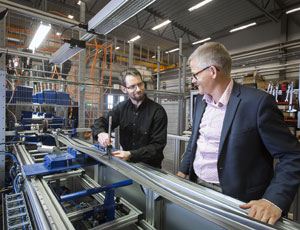Automotive: Cold-forming returns
Cold-forming steels have several advantages and are experiencing a resurgence in the automotive industry. This trend is likely to continue.
More and more automotive manufacturers are realizing that hot forming is a costly process and not so favorable from the sustainability perspective. To date, there has not been a range of cold-forming steels with the right properties available in the market. Now SSAB’s cold-formed Advanced High Strength steels (AHSS) offer car manufacturers a cost-efficient and environmentally sound alternative. Of course, sometimes hot forming is the only option allowing parts with a complex geometry and SSAB can provide solutions for this too.

Alexander Vigander and Johan Eriksson from Ortic.
New cold-forming steels have been developed that can live up to the high strength and geometric demands of modern automotive applications. Those companies in the forefront will have a competitive cost advantage.
Easier to weld and join
Cold- forming steels are easier to weld and join due to their leaner alloy composition. Cold-formed applications can also help to avoid some of the challenges with different kind of embrittlement. Cold-forming steels are also a more environmentally sound alternative – without the need for energy-intensive heating processes.
The main advantages of cold forming are lower processing costs, including tooling costs, productivity, and energy consumption. With hot forming there is also the need for more expensive laser trimming.
Higher crash test ratings
“With component innovations matching the properties of the steel, a car body made up mostly of cold-formable Docol can be expected to obtain high crash test ratings, while being also lightweight,” says business development specialist Kenneth Olsson from SSAB.
Really high-strength steel should be used where it makes sense in a car. SSAB can contribute to the automotive industry with our extensive knowledge and experience of cold-forming steels. Using AHSS for selected applications costs only a third of the price of aluminum, for example.
By increasing the share of AHSS steel in components, car manufacturers can both lower vehicle weight and increase the percentage of recyclable parts. Docol’s high strength-to-weight ratio means that thinner steel can be used without sacrificing strength. This boosts fuel efficiency, improves driving performance and cuts costs.
Docol in bumpers help shed weight and improve bumper performance
Tags:


